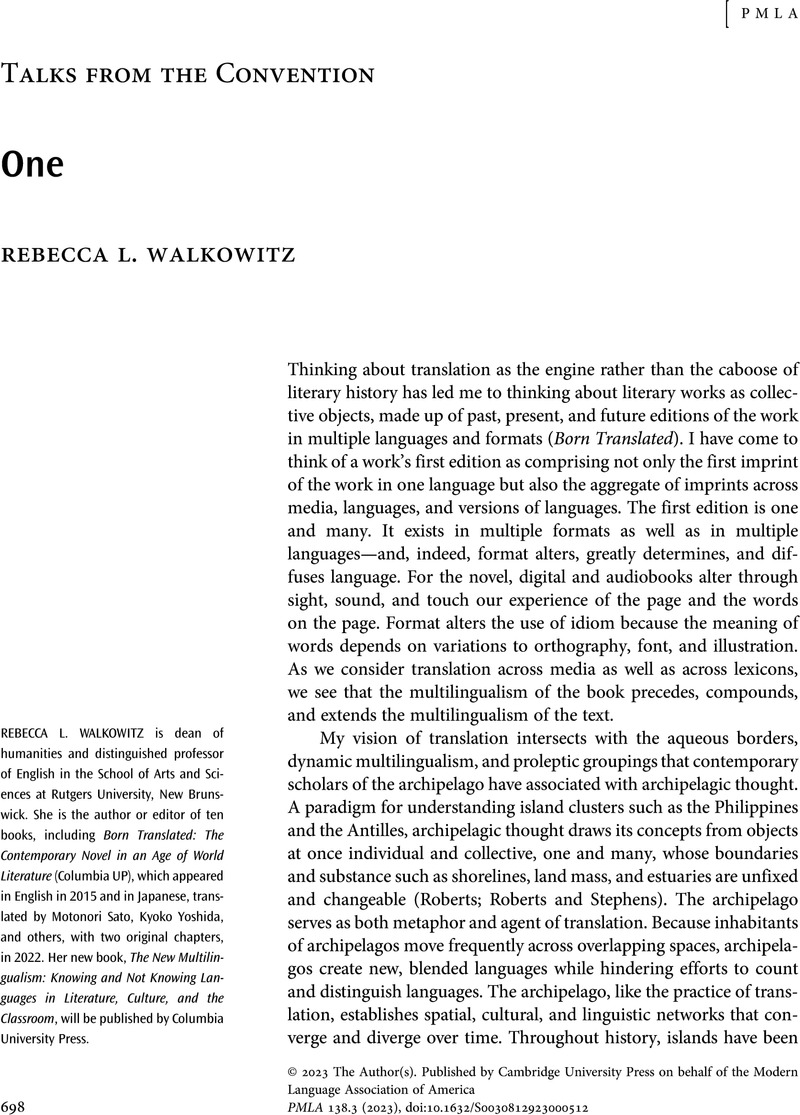No CrossRef data available.
Article contents
Abstract
An abstract is not available for this content so a preview has been provided. Please use the Get access link above for information on how to access this content.

Information
- Type
- Talks from the Convention
- Information
- Copyright
- Copyright © 2023 The Author(s). Published by Cambridge University Press on behalf of the Modern Language Association of America
References
Works Cited
Acuna, Kirsten. “Why ‘West Side Story’ Doesn't Have Subtitles for Spanish.” Insider, 8 Dec. 2021, www.insider.com/why-west-side-story-doesnt-have-subtitles-2021-12.Google Scholar
Dargis, Manohla. “‘Drive My Car’ Review: A Director Takes Your Heart for a Spin.” The New York Times, 24 Nov. 2021, www.nytimes.com/2021/11/24/movies/drive-my-car-review.html.Google Scholar
Derrida, Jacques. Monolingualism of the Other; or, The Prosthesis of Origin. Translated by Patrick Mensah, Stanford UP, 1998.Google Scholar
Dettmar, Kevin. “What ‘Drive My Car’ Reveals on a Second Viewing.” The New Yorker, 23 Mar. 2022, www.newyorker.com/culture/culture-desk/what-drive-my-car-reveals-on-a-second-viewing.Google Scholar
Drive My Car. Directed by Ryusuke Hamaguchi, Bitters End, 2021. Criterion, 2022. DVD.Google Scholar
Miller, D. A. “Drive My Car Drives Me Crazy.” Drive My Car: A Symposium on Hamaguchi's Cross-Media Vehicle, Keio University, Kyoto, 18 June 2022.Google Scholar
Murakami, Haruki. “Drive My Car.” Men without Women, translated by Gabriel, Philip and Ted Goossen, Vintage, 2018, pp. 3–40.Google Scholar
Pachinko. Created by Sooh Hugh, Blue Marble Pictures / Apple TV, 2022.Google Scholar
Roberts, Brian Russell. Borderwaters: Amid the Archipelagic States of America. Duke UP, 2021.Google Scholar
Roberts, Brian Russell, and Stephens, Michelle Ann, editors. Archipelagic American Studies. Duke UP, 2017.Google Scholar
Roma. Directed by Alfonso Cuarón, Esperanto Filmoj, 2018. Criterion, 2020. DVD.Google Scholar
Sakai, Naoki. “How Do We Count a Language? Translation and Discontinuity.” Translation Studies, vol. 2, no. 1, 2009, pp. 71–88.CrossRefGoogle Scholar
Walkowitz, Rebecca L. Born Translated: The Contemporary Novel in an Age of World Literature. Columbia UP, 2015.CrossRefGoogle Scholar
Walkowitz, Rebecca L. “English as an Additional Language.” PMLA, vol. 137, no. 4, Oct. 2022, pp. 942–50.Google Scholar
Walkowitz, Rebecca L. “Less than One Language: Typographic Multilingualism and Postanglophone Fiction.” SubStance, vol. 50, no. 1, 2021, pp. 95–115.CrossRefGoogle Scholar
Walkowitz, Rebecca L. “On Not Knowing: Lahiri, Tawada, Ishiguro.” New Literary History, vol. 51, no. 2, spring 2020, pp. 323–46.CrossRefGoogle Scholar
West Side Story. Directed by Stephen Spielberg, Amblin Entertainment, 2021. HBO Max app.Google Scholar

